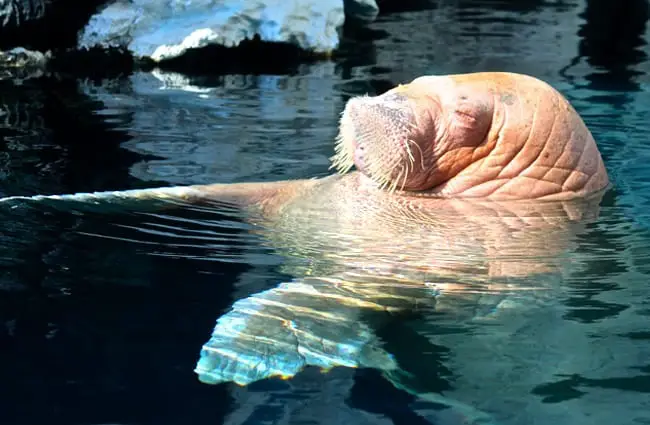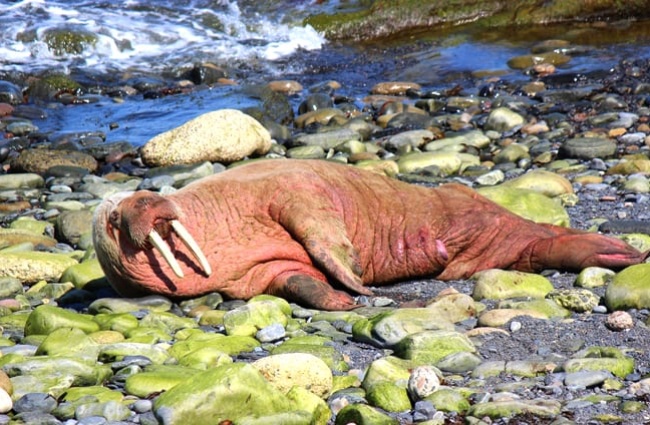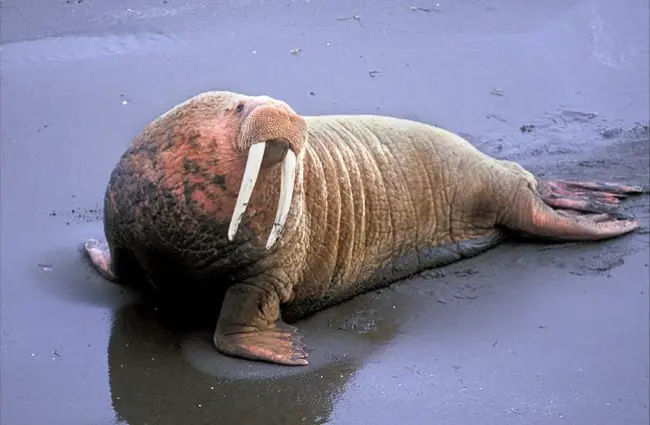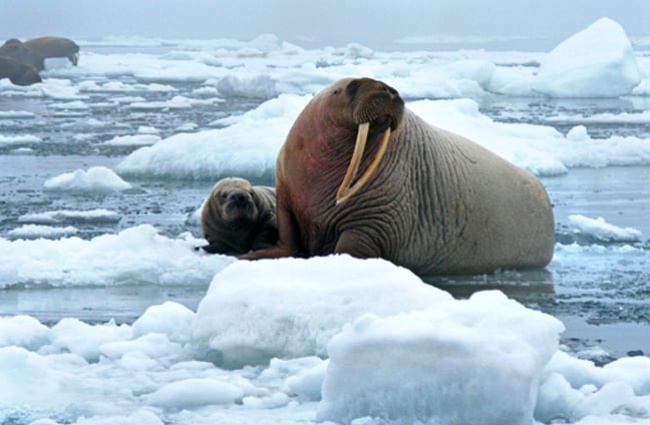A Deep Dive into the World of Walruses
The walrus, a magnificent marine mammal famed for its impressive tusks and bulky physique, occupies a unique niche in the Arctic ecosystem. More than just an iconic symbol of the polar regions, the walrus boasts a fascinating evolutionary history, complex social behaviors, and a vital role in maintaining the health of its icy habitat. This comprehensive guide explores all facets of walrus life, from their physical characteristics and feeding habits to their reproductive strategies, conservation status, and cultural significance.

Physical Characteristics and Adaptations
Walruses are instantly recognizable. These large pinnipeds, the group including seals and sea lions, exhibit distinct sexual dimorphism. Males typically weigh between 800 and 1,700 kilograms, while females are smaller, ranging from 500 to 900 kilograms. The most striking feature of the walrus is undoubtedly its tusks, which are elongated canine teeth present in both males and females. These tusks, reaching up to a meter in length, are not just for show. They serve multiple purposes, including hauling themselves onto ice, defending against predators, establishing dominance, and foraging for food.
Beneath their thick blubber layer and sparse coat of fur, walruses possess a complex network of blood vessels that regulate body temperature in the frigid Arctic waters. Their bodies are streamlined for efficient swimming, and they can hold their breath for up to 30 minutes. A notable adaptation is their sensitivity to whiskers, called vibrissae, which help them detect prey in murky waters. Their large size and buoyancy also contribute to their success in the marine environment.
Habitat and Distribution
Walruses are primarily found in the shallow waters of the Arctic region, specifically in coastal areas of Russia, Greenland, Canada, and Alaska. They prefer ice floes and shallow continental shelves where they can rest, breed, and forage for food. The distribution of walruses is largely dictated by the availability of sea ice, which serves as a crucial platform for resting and giving birth. Traditionally, two subspecies have been recognized – the Atlantic walrus (Odobenus rosmarus rosmarus) and the Pacific walrus (Odobenus rosmarus divergens). Some scientists also recognize a third, the Laptev Sea walrus (Odobenus rosmarus laptevi).

Diet and Foraging Behavior
Walruses are benthic feeders, meaning they forage for food on the seafloor. Their diet primarily consists of clams, mussels, snails, and other invertebrates. They use their sensitive whiskers to locate prey buried in the sediment and employ powerful suction to extract it. Walruses can consume an astonishing amount of food in a single feeding session, often up to 2,000 clams. They often congregate in large herds to forage in productive areas. Their feeding behavior plays a significant role in shaping the benthic communities of the Arctic seabed.
Evolutionary History
The evolutionary history of walruses traces back to the Miocene epoch, approximately 23 to 5 million years ago. Early walruses, known as Odobenus antiquus, inhabited the North Atlantic and Pacific oceans. Fossil evidence suggests that they were smaller and lacked the prominent tusks seen in modern walruses. Over millions of years, walruses gradually evolved their distinctive features, adapting to the harsh Arctic environment. Their tusks likely evolved from smaller teeth used for scraping and digging, eventually becoming elongated for more efficient foraging and defense. Modern walruses represent the culmination of this long evolutionary process.

Social Structure and Reproduction
Walruses are generally social animals, though their social structure is not as complex as that of some other marine mammals. They often gather in large herds, particularly during the breeding season. Males compete for dominance and access to females, engaging in vocalizations and physical displays. Breeding typically occurs in late winter and early spring. After a gestation period of approximately 15 to 16 months, females give birth to a single calf. Calves are heavily dependent on their mothers for milk and protection, and they remain with them for up to two years.
Ecological Role and Inter‑species Interactions
Walruses play a vital role in the Arctic ecosystem. As benthic feeders, they influence the composition and abundance of benthic communities. Their foraging activities can also create upwelling currents that bring nutrients to the surface, supporting the growth of phytoplankton and other primary producers. Walruses share their habitat with other iconic Arctic species, including polar bears, seals, and whales. Polar bears occasionally prey on walruses, mainly targeting calves or weakened individuals, but this is rare. Walruses and seals compete for food resources.

Walruses and Humans: A Historical Perspective
For millennia, walruses have held cultural and economic significance for Indigenous communities in the Arctic. They have been hunted for meat, blubber, and hides, providing essential resources for survival. Walrus ivory has also been used to create tools, ornaments, and art. However, excessive hunting in the 19th and 20th centuries led to significant declines in walrus populations. In recent decades, conservation efforts have helped to stabilize populations, but they remain vulnerable to threats such as climate change and oil and gas development.
Conservation Status and Threats
The conservation status of walruses varies depending on the subspecies and geographic region. The Atlantic walrus is listed as Vulnerable by the International Union for Conservation of Nature, while the Pacific walrus is listed as Near Threatened. The Laptev Sea walrus population is of particular concern. The primary threats facing walruses today include climate change, which is causing a rapid decline in sea ice habitat, and human activities such as oil and gas exploration and shipping. These threats can disrupt their foraging behavior, breeding patterns, and overall survival.
Encountering Walruses in the Wild
If you are fortunate enough to encounter walruses in the wild, it is crucial to maintain a safe distance and avoid disturbing them. Never approach them on foot or by boat. Keep your voice down and avoid making sudden movements. Remember that walruses are powerful animals and can become aggressive if they feel threatened. Report any unusual behavior or signs of distress to the appropriate authorities.

Caring for Walruses in Captivity
Caring for walruses in captivity requires specialized facilities and expertise. They need large, spacious enclosures with access to both land and water. The water should be kept cold and clean, and the enclosure should be designed to mimic their natural habitat. Walruses require a varied diet consisting of fish, shellfish, and other marine invertebrates. Enrichment activities are essential to stimulate their mental and physical well‑being. Experienced veterinary care is also crucial to monitor their health and address any medical issues.
Interesting Walrus Facts
- Walruses can live for up to 40 years in the wild.
- They can weigh up to 1,800 kilograms.
- Walruses use their tusks to haul themselves onto ice and defend against predators.
- They can dive to depths of up to 70 meters.
- Calves are born with a thick coat of fur that they shed after a few months.
- Walruses can change the color of their skin based on temperature and blood flow.

The walrus, a magnificent symbol of the Arctic, faces an uncertain future in a rapidly changing world. By understanding their biology, behavior, and ecological role, we can work to protect these remarkable animals and ensure their survival for generations to come.

![Red Angus Closeup of a beautiful Red Angus cowPhoto by: U.S. Department of Agriculture [pubic domain]https://creativecommons.org/licenses/by/2.0/](https://animals.net/wp-content/uploads/2020/03/Red-Angus-4-238x178.jpg)




![Red Angus Closeup of a beautiful Red Angus cowPhoto by: U.S. Department of Agriculture [pubic domain]https://creativecommons.org/licenses/by/2.0/](https://animals.net/wp-content/uploads/2020/03/Red-Angus-4-100x75.jpg)

